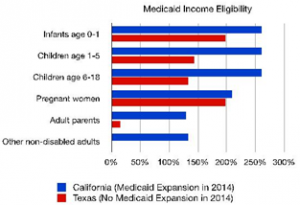The Affordable Care Act aims to extend health insurance to tens of millions more Americans through two major routes: by giving people information and in many cases tax credits to help them purchase private insurance plans offered on state or national “exchanges,” or online marketplaces; and by giving the fifty U.S. states plus the District of Columbia additional federal funds to expand their Medicaid programs to insure all low-income people just above as well as below the federal poverty line. States have a key role in implementing health reform. Each state can choose to run its own exchange marketplace and help its residents learn about their options for purchasing affordable plans. Each state also decides whether or not to accept new federal subsidies to expand Medicaid (covering 93% of the costs from 2014 through 2022). What states do—or refuse to do—makes a big difference, as a comparison of the nation’s two largest states, California and Texas, makes clear. California is leading the way in showing that Affordable Care can work, while authorities in Texas are obstructing implementation with gusto.
Shared Challenges—But Greater Needs in Texas
California is home to more than 38 million people, and Texas to more than 26 million. Both states are ethnically and racially diverse, with large non-white and foreign-born populations, and both had large uninsured populations prior to reform. Uninsurance rates are markedly higher in the Lone Star state, however.
| Percent Uninsured | California | Texas |
| Total population | 17.87% | 24.61% |
| Hispanics | 26.45% | 36.95% |
| Black | 16.28% | 21.90% |
| Children | 9.62% | 15.58% |
| Women | 16.32% | 23.44% |
Contrasting Policy Responses

Both California and Texas residents have a lot to gain from health reform—but Texans clearly stand to gain more. The responses of state authorities do not line up with residents’ needs. Under the leadership of a Democratic governor and legislature, California is enthusiastically embracing the full implementation of health reform. But in Texas a conservative Republican governor and legislature are refusing to cooperate with health reform, and in some cases are actively obstructing enrollment efforts by federal authorities and local civic groups.
- California has set up and is running its own health insurance exchange, called “Covered California,” but Texas has not set up its own exchange and refuses to cooperate with the federally facilitated exchange for Texas residents.
- California provides funding for civic and nonprofit groups to reach out to uninsured residents—especially in minority communities—and help them sign up for insurance coverage. Texas, by contrast, passed laws that make it very difficult for volunteers or federally funded “navigators” to help uninsured residents find options and make choices on the exchange.
- California previously had a much more inclusive and generous Medicaid program than Texas, and it has agreed to carry through the federally funded Medicaid expansion to more fully insure the near-poor. California is automatically enrolling eligible poor people. In sharp contrast, Texas has refused to take new federal funds to expand its Medicaid program—which continues to offer practically no help to poor adults who are not disabled, pregnant, or parents of small children.
As of 2014, with California accepting the Medicaid expansion and Texas declining, the two states have sharper differences than ever in income eligibility for different population groups to get Medicaid coverage. In the chart below, 100% refers to an eligibility set at the federal poverty level—an annual family income of about $11,670 for a single person, $15,730 for a two-person family, and $19,790 for a three-person family.
Divergent Paths
Not surprisingly, California is making rapid progress in realizing the potential of Affordable Care reforms. More than 728,000 Californians had purchased insurance plans on Covered California through the end of January 2014—taking the state more than half way to its first-year enrollment target. Through the same date, just over 207,000 Texans had managed to purchase plans on the federal insurance exchange, about a third of those expected for the first year. The Medicaid enrollment gap is even greater. More than 2.2 million Californians were added to that state’s expanded Medicaid program by the end of January, compared to just over 80,000 Texans who signed up after realizing they were already eligible for the existing state Medicaid program.Clearly, cooperation versus obstruction by state leaders makes a huge difference. California is on course to cover a large portion of its uninsured residents through Affordable Care. But unless Texas authorities change course, their state will continue to have the dubious honor of being home to the largest share of Americans who do not have private or public health insurance.
—
Data for this brief were drawn from 2013 Census Bureau Current Population Surveys.


 Research to Improve Policy: The Scholars Strategy Network seeks to improve public policy and strengthen democracy by organizing scholars working in America's colleges and universities. SSN's founding director is Theda Skocpol, Victor S. Thomas Professor of Government and Sociology at Harvard University.
Research to Improve Policy: The Scholars Strategy Network seeks to improve public policy and strengthen democracy by organizing scholars working in America's colleges and universities. SSN's founding director is Theda Skocpol, Victor S. Thomas Professor of Government and Sociology at Harvard University.